GT 1300 Junior
| Alfa Romeo 105/115 series coupés | |
|---|---|
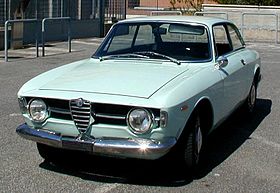
Alfa Romeo GT 1300 Junior, early model
|
|
| Overview | |
| Manufacturer | Alfa Romeo |
| Production | 1963–1977 |
| Assembly |
Arese, Milan, Italy Setúbal, Portugal (Movauto) Rosslyn plant, South Africa |
| Designer |
Giorgetto Giugiaro at Bertone (Sprint, GT, GTV) Carrozzeria Touring (GTC) Ercole Spada at Zagato (Junior Zagato) |
| Body and chassis | |
| Class | Sports car |
| Body style | 2-door 2+2 coupé 2-door cabriolet |
| Layout | Front-engine, rear-wheel-drive |
| Related | |
| Powertrain | |
| Engine | Alfa Romeo Twin Cam |
| Transmission | 5-speed manual |
| Chronology | |
| Predecessor | Alfa Romeo Giulietta Coupé |
| Successor | Alfa Romeo Alfetta GT, GTV & GTV6 |
| Alfa Romeo Giulia Sprint GT | |
|---|---|
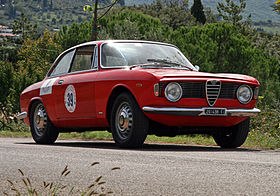
1965 Alfa Romeo Giulia Sprint GT
|
|
| Overview | |
| Production | 1963–1965 |
| Body and chassis | |
| Body style | 2-door coupé |
| Powertrain | |
| Engine | 1.6 L Twin Cam I4 |
| Dimensions | |
| Wheelbase | 2,350 mm (92.5 in) |
| Length | 4,080 mm (160.6 in) |
| Width | 1,580 mm (62.2 in) |
| Height | 1,315 mm (51.8 in) |
| Kerb weight | 950 kg (2,094 lb) |
| Alfa Romeo Giulia GTC | |
|---|---|
 |
|
| Overview | |
| Production | 1964–1966 around 1,000 produced |
| Designer | Carrozzeria Touring |
| Body and chassis | |
| Body style | 2-door cabriolet |
| Powertrain | |
| Engine | 1.6 L Twin Cam I4 |
| Dimensions | |
| Wheelbase | 2,350 mm (92.5 in) |
| Length | 4,080 mm (160.6 in) |
| Width | 1,580 mm (62.2 in) |
| Height | 1,315 mm (51.8 in) |
| Kerb weight | 905 kg (1,995 lb) |
| Alfa Romeo Giulia Sprint GT Veloce | |
|---|---|
 |
|
| Overview | |
| Production | 1965–1968 |
| Body and chassis | |
| Body style | 2-door coupé |
| Powertrain | |
| Engine | 1.6 L Twin Cam I4 |
| Transmission | 5-speed manual |
| Dimensions | |
| Length | 4,089 mm (161.0 in) |
| Width | 1,575 mm (62.0 in) |
| Height | 1,321 mm (52.0 in) |
| Kerb weight | 1,012 kg (2,231 lb) |
| Alfa Romeo 1750 GT Veloce | |
|---|---|
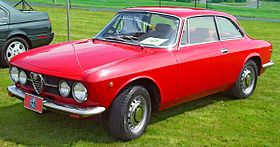 |
|
| Overview | |
| Production | 1967–1971 |
| Body and chassis | |
| Body style | 2-door coupé |
| Powertrain | |
| Engine | 1.8 L Twin Cam I4 |
| Dimensions | |
| Wheelbase | 2,350 mm (92.5 in) |
| Length | 4,089 mm (161.0 in) |
| Width | 1,575 mm (62.0 in) |
| Height | 1,321 mm (52.0 in) |
| Kerb weight | 1,038 kg (2,288 lb) |
| Alfa Romeo 2000 GT Veloce | |
|---|---|
 |
|
| Overview | |
| Production | 1971–1976 |
| Body and chassis | |
| Body style | 2-door coupé |
| Powertrain | |
| Engine | 2.0 L Twin Cam I4 |
| Dimensions | |
| Wheelbase | 2,350 mm (92.5 in) |
| Length | 4,089 mm (161.0 in) |
| Width | 1,575 mm (62.0 in) |
| Height | 1,321 mm (52.0 in) |
| Kerb weight | 1,028 kg (2,266 lb) |
| Alfa Romeo GT 1300 Junior | |
|---|---|
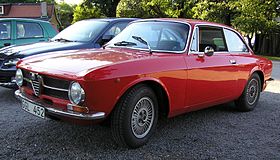
1972 GT 1300 Junior with optional turbina wheels.
|
|
| Overview | |
| Production | 1965–1974 (GT 1300 Junior) 1974–1976 (1.3 GT Junior) |
| Body and chassis | |
| Body style | 2-door coupé |
| Powertrain | |
| Engine | 1.3 L Twin Cam I4 |
| Dimensions | |
| Length | 4,080 mm (160.6 in) |
| Width | 1,580 mm (62.2 in) |
| Height | 1,310 mm (51.6 in) |
| Kerb weight | 930 kg (2,050 lb) |
| Alfa Romeo GT 1600 Junior | |
|---|---|

1976 GT 1600 Junior.
|
|
| Overview | |
| Production | 1972–1975 (GT 1600 Junior) 1974–1976 (1.6 GT Junior) |
| Body and chassis | |
| Body style | 2-door coupé |
| Powertrain | |
| Engine | 1.6 L Twin Cam I4 |
| Alfa Romeo Junior Z Alfa Romeo 1600 Junior Z |
|
|---|---|
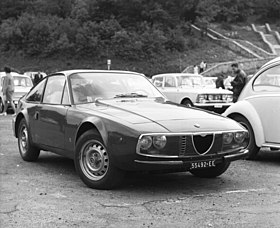
Alfa Romeo Junior Z
|
|
| Overview | |
| Production | Junior Z: 1969–1972 1600 Junior Z: 1972–1976 |
| Designer | Ercole Spada at Zagato |
| Body and chassis | |
| Body style | 2-door coupé |
| Powertrain | |
| Engine | Junior Z: 1.3 L Twin Cam I4 1600 Junior Z: 1.6 L Twin Cam I4 |
| Transmission | 5-speed manual |
| Dimensions | |
| Wheelbase | 2,250 mm (88.6 in) |
| Length | Junior Z: 3,900 mm (153.5 in) (Junior Z) 1600 Junior Z: 4,000 mm (157.5 in) |
| Width | 1,550 mm (61.0 in) |
| Height | 1,280 mm (50.4 in) |
| Kerb weight | Junior Z: 920 kg (2,028 lb) 950 kg (2,094 lb) (1600 Junior Z) |
The Alfa Romeo 105 and 115 series coupés were a range of cars made by the Italian manufacturer Alfa Romeo from 1963 until 1977, based on a shortened floorpan from the Giulia saloon. They were the successors to the Giulietta Sprint coupé.
The basic body shape shared by all models was designed by Giorgetto Giugiaro for Bertone. It was one of his first major projects for Bertone, and borrowed heavily from his earlier design for the Alfa Romeo 2000 Sprint/2600 Sprint. The balance of glass and metal, the influence of the shape of the front and rear glass on the shape of the cabin, and the flat grille with incorporated headlamps were groundbreaking styling features for the era.
A limited production (1000 units) convertible was a modification from the standard car by Touring of Milan, offered as a catalogue model by Alfa Romeo called the Giulia Sprint GTC.
A small number of the GT Junior Zagato were also built with a very different, aerodynamic two-seater coupé body designed by Ercole Spada for Zagato of Milan. These too were offered by Alfa Romeo as catalogue models, as the GT 1300 Junior Zagato and later GT 1600 Junior Zagato.
All models feature the four cylinder, all-light-alloy Alfa Romeo Twin Cam engine in various cubic capacities from 1290 cc to 1962 cc, all with two valves per cylinder. All versions of this engine fitted to the 105 series coupés featured twin carburettors, except for US market 1750 GTV and 2000 GTV cars which were fitted with fuel injection. Competition models featured cylinder heads with twin spark plugs. Common to all models was also a 5-speed manual transmission and disc brakes on all four wheels. The rear suspension uses a beam axle with coil springs. Air conditioning and a limited slip rear differential were optional on the later models.
...
Wikipedia
